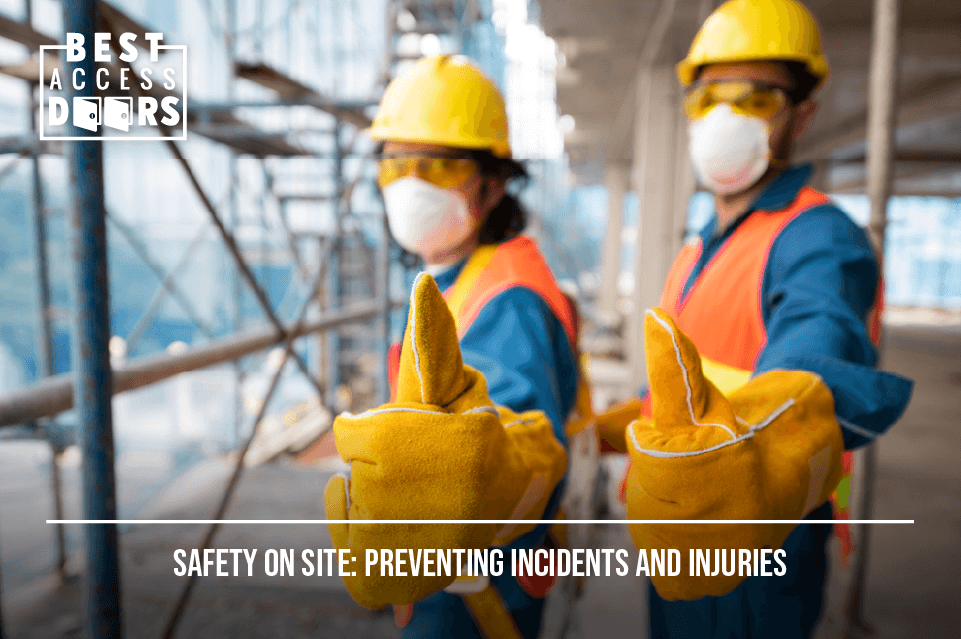Safety on Site: Preventing Incidents and Injuries
Posted by Best Access Doors on 12th Dec 2018
At Best Access Doors we share access panels that promote safety and prevent any further damages to a building and space – we also are an advocate for improving safety on site. Best Access Doors shares insight on how to improve safety and the prevention of injuries and incidences on any job site whether it is commercial or residential.
Communicate
Communication whether it is about safety or what the building process is important. What having an open line of discussion does is it creates a free and safe environment along with a company culture that promotes and endorses safe practices. What communication on site and amongst colleagues does is it means being active when things are not being done correctly or not to standard.
For example, when working with heavy machinery or cutting an opening for an access panel installation, if a member of the team sees that there are potential hazards, it means taking the step to speak up. If they don’t speak up, and an injury occurs, it can not only be traumatic for the guys on site, but it can result in project delays and issues.
Promoting open lines of discussion is important because it improves safety and when working in the construction industry, safety is essential.
Preparedness
While having First Aid Training and a few bandages for those “just-in-case” scenarios are good, there is more to preparedness than just these small gestures. Preparedness means having a fully stocked and dated First Aid Kit not only on-site, but that is easily visible and accessible. Imagine using a drywall lifter and an injury were to take place – do staffers and workers on site know what to do? Do they know how to seek help?
Preparedness does not have to be overly time-consuming if anything it can be done on a weekly or bi-weekly touchpoint meeting. Preparedness on-site can prevent injuries before they happen but also mitigate any potential risks; however, the key thing is that everyone, not just the project manager but the employees as well are prepared. It is about communication and engagement.
Equipment
Working in the construction and remodeling industry, one would think that only equipment that is used is merely a hard hat and steel-toe boots. In actuality, though there is much more to the equipment that is worn on site but also on the task at hand. When it comes to personal protective equipment (PPE) the type of equipment required varies on the task at hand.
For example, when working with drywall installation like BA-F2A Drywall Inlay Access Panel, wearing protective eyewear, gloves and boots can prevent any unnecessary injury.
Safety equipment though is not limited to what one wears – it can also mean the tools and machinery used. For example, the use of a table saw or drill – these can be if the user is not skilled or comfortable with the use, can be very dangerous. The use of equipment must always be accompanied by training, education and safety.
Routine Maintenance and Check Points
Having a first aid kit, making sure that staff are trained and that people use the right equipment and protective equipment – these cannot be just done one off. Routine maintenance and having regular check-points provides consistency in the information and ensures safety on-site. Safety can sometimes be taken for granted; however, when a project manager or builder promotes safety on-site and its importance, then the first step in preventing incidents and injuries are factored in.
Safety on site – project success
At Best Access Doors, we offer 5-star products and services but more importantly, we strive to provide helpful tips when it comes to the ever so changing and dangerous industry of construction and building. While safety can sometimes seem so obvious with what to do and wear, the truth of the matter is, every year the construction industry finds itself faced with hundreds if not thousands of injuries that happen on site. While some workers are able to recover and continue, some are affected so much so that they can’t go back to work.
For more helpful tips on how to promote safety on-site and what contractors, builders and clients can do, visit our blog.
Share our story - get our 2024 Catalog for FREE!

